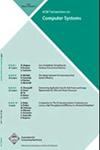Comprehensive multivariate extrapolation modeling of multiprocessor cache miss rates
IF 1.8
4区 计算机科学
Q2 COMPUTER SCIENCE, THEORY & METHODS
引用次数: 5
Abstract
Cache miss rates are an important subset of system model inputs. Cache miss rate models are used for broad design space exploration in which many cache configurations cannot be simulated directly due to limitations of trace collection setups or available resources. Often it is not practical to simulate large caches. Large processor counts and consequent potentially high degree of cache sharing are frequently not reproducible on small existing systems. In this article, we present an approach to building multivariate regression models for predicting cache miss rates beyond the range of collectible data. The extrapolation model attempts to accurately estimate the high-level trend of the existing data, which can be extended in a natural way. We extend previous work by its applicability to multiple miss rate components and its ability to model a wide range of cache parameters, including size, line size, associativity and sharing. The stability of extrapolation is recognized to be a crucial requirement. The proposed extrapolation model is shown to be stable to small data perturbations that may be introduced during data collection.We show the effectiveness of the technique by applying it to two commercial workloads. The wide design space contains configurations that are much larger than those for which miss rate data were available. The fitted data match the simulation data very well. The various curves show how a miss rate model is useful for not only estimating the performance of specific configurations, but also for providing insight into miss rate trends.多处理器缓存缺失率的综合多元外推模型
缓存缺失率是系统模型输入的一个重要子集。缓存缺失率模型用于广泛的设计空间探索,其中由于跟踪收集设置或可用资源的限制,许多缓存配置不能直接模拟。通常,模拟大型缓存是不实际的。在现有的小型系统上,大型处理器数量和由此产生的潜在的高度缓存共享通常是不可复制的。在本文中,我们提出了一种构建多元回归模型的方法,用于预测超出可收集数据范围的缓存缺失率。外推模型试图准确估计现有数据的高层趋势,可以自然地进行扩展。我们扩展了之前的工作,它适用于多个缺失率组件,并且能够模拟广泛的缓存参数,包括大小、行大小、结合性和共享。外推的稳定性被认为是一个至关重要的要求。所提出的外推模型对数据收集过程中可能引入的小数据扰动是稳定的。我们通过将其应用于两个商业工作负载来展示该技术的有效性。宽泛的设计空间包含的配置比缺失率数据可用的配置大得多。拟合数据与仿真数据吻合较好。各种曲线显示了脱靶率模型不仅对估计特定配置的性能很有用,而且对脱靶率趋势也很有用。
本文章由计算机程序翻译,如有差异,请以英文原文为准。
求助全文
约1分钟内获得全文
求助全文
来源期刊

ACM Transactions on Computer Systems
工程技术-计算机:理论方法
CiteScore
4.00
自引率
0.00%
发文量
7
审稿时长
1 months
期刊介绍:
ACM Transactions on Computer Systems (TOCS) presents research and development results on the design, implementation, analysis, evaluation, and use of computer systems and systems software. The term "computer systems" is interpreted broadly and includes operating systems, systems architecture and hardware, distributed systems, optimizing compilers, and the interaction between systems and computer networks. Articles appearing in TOCS will tend either to present new techniques and concepts, or to report on experiences and experiments with actual systems. Insights useful to system designers, builders, and users will be emphasized.
TOCS publishes research and technical papers, both short and long. It includes technical correspondence to permit commentary on technical topics and on previously published papers.
 求助内容:
求助内容: 应助结果提醒方式:
应助结果提醒方式:


